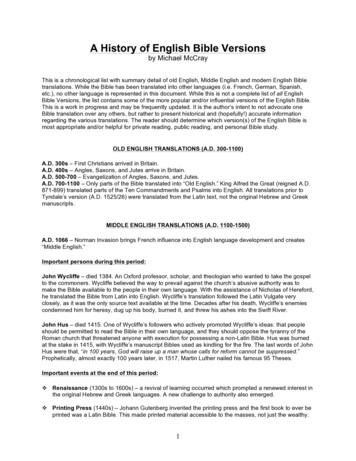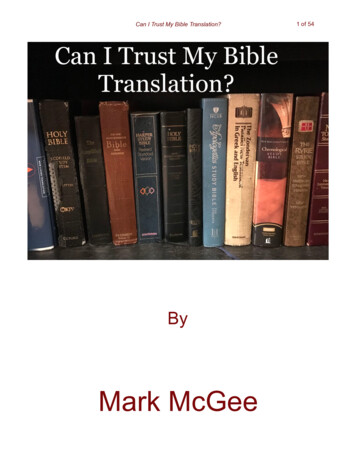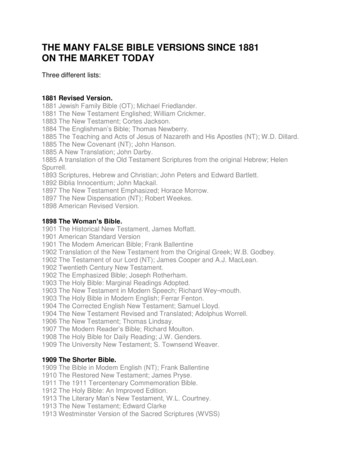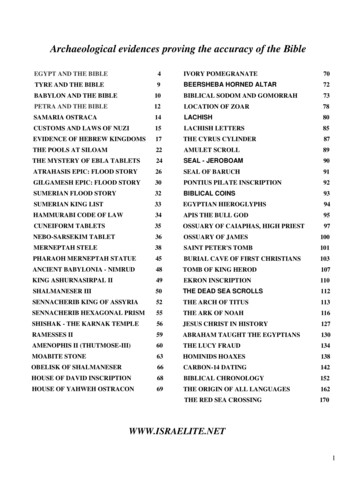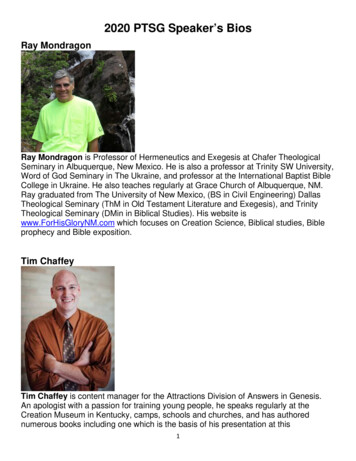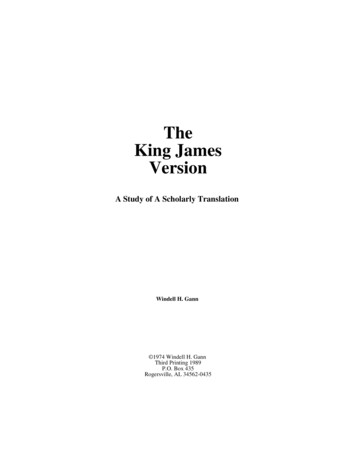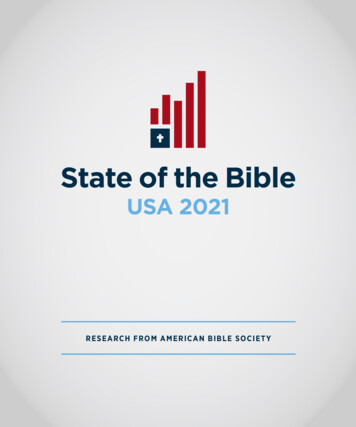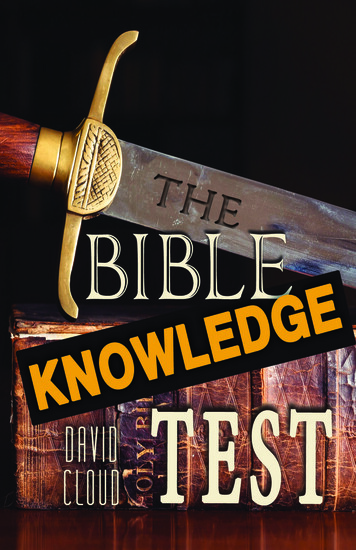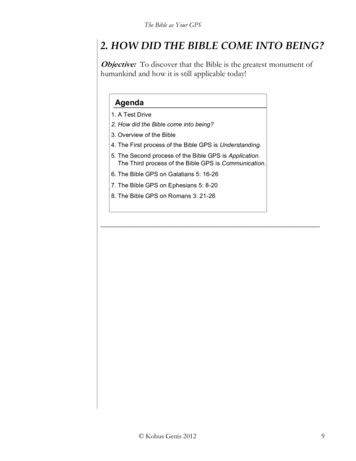
Transcription
The Bible as Your GPS2. HOW DID THE BIBLE COME INTO BEING?Objective: To discover that the Bible is the greatest monument ofhumankind and how it is still applicable today!Agenda1. A Test Drive2. How did the Bible come into being?3. Overview of the Bible4. The First process of the Bible GPS is Understanding.5. The Second process of the Bible GPS is Application.The Third process of the Bible GPS is Communication.6. The Bible GPS on Galatians 5: 16-267. The Bible GPS on Ephesians 5: 8-208. The Bible GPS on Romans 3: 21-26 Kobus Genis 20129
The Bible as Your GPSHow THE BIBLE came into being. (Schematic)TraditionsOralLanguagesWrittenHebrew 1000BCAramaic 400BCGreek 90ADJamnia(Jewish Council) 90ADCouncilsOT Canon withoutApocryphaLatin (Vulgate -255)397AD 1546 ADCarthage 397ADNT Canon(Early Churchaccepts thedecisions ofJamnia & Carthage)EnglishKing James 1611 ADTrent 1546AD(Located in Northern Italy)Roman Catholics officiallydefined the CatholicCanon which include der theGreat)RomanPersian Kobus Genis 201210
The Bible as Your GPSHow THE BIBLE came into beingA Process1. Genuine.2. Authenticity.3. Divine authorityand inspiration.APOCRYPHACANONWhy should we have some understanding of how the Bible came to us? The Bible did not just simply drop from the sky, but it came into being througha fascinating, but complicating process. To best understand the process we need tobe aware of the dispute regarding which books are, or are not, included. Thebooks that made it into the Bible are called the CANON. "Canon" is a Greekword which means a rule or measuring line.A Canonical book, therefore, passes the test of being authentic, genuine, and ofdivine authority and inspiration.The debate regarding the canon and apocrypha stems back to the early churchand the Greek translation of the Old Testament known as the Septuagint. AfterJerusalem had been sacked by the Romans in 70 AD, there was another Diasporaof Jewish people all over the world. Spoken and written Hebrew remained strongin the lands of Judea/Palestine, as opposed to Alexandria, the home of manyGreek speaking Jews. This lack of familiarity with the Hebrew Scriptures gaveimpetus for Greek speaking Jews, to translate the Hebrew scriptures. Thistranslation is called the Septuagint.There were other writings circulating, in Alexandria especially, which werebeing widely read. These writings were included in the Septuagint. Thesewritings are called “Apocrypha” by Protestants.The word Apocrypha comes from the Greek word, meaning “hidden” or“concealed”. The term generally refers to religious writings found in theSeptuagint and Latin Vulgate, but not in the Hebrew Bible. Kobus Genis 201211
The Bible as Your GPSHow THE BIBLE came into beingA ProcessThe JewsTheRomanCatholicChurchThe ProtestantsThe Apocrypha consists of 15 books of Jewish literature written during theintertestamental period.What is the significance of the Apocrypha?For Christians and Jews, these books represent a continuation of sacredwritings in the Jewish community up until Christ came. They paint a picture of thecultural and religious mindset in Judaism before the appearance of Christianity.They set the scene for the coming of Jesus and help the reader to relate to thesocial and religious context Jesus found in Israel.The acceptance of the apocrypha: As a general summary:* The Jews . accept the apocrypha as part of theirScriptures.* Protestants also . accept the Apocrypha as Scripture,though some ascribe to them value as "good and useful reading" and "for exampleof life and instruction of manners."* The Roman Catholic Church . 12 of the 15 apocryphal books atthe Council of Trent, April 8, 1546 A.D. as canonical (omitting I & II Esdras andthe defaulter of Manassah from the above list). Roman Catholics call thesewritings “deuterocanonicals” or “second canon” because its inspiration wasrecognized later.Roman Catholics argue that the Apocrypha was an integral part of the earlychurch and should be included in the list of inspired Old Testament books.However, Protestants, Roman Catholics, and Greek Orthodox Christians on the same 27 books for the composition of the New Testament. Kobus Genis 201212
The Bible as Your GPSHow THE BIBLE came into being.LKTATALKKTALTALKTALKLKTATALKTALK2500 BC1. The TraditionsLKTATALKTALKLKTAORALThe Bible evolved over a time span of approximately 2000 years. The timespan can be divided in an tradition and a tradition.The oral tradition is likely dated to the time of Abraham, around 1800 BC.Before anything in the Bible was written down, people told stories about God andGod's relationship with the people we now read about in the Bible. The oraltradition lasted for many years as families passed along the stories of theirancestors to each new generation. In the case of the Jewish Scriptures (OldTestament), some stories were told for centuries before they were written down ina final form. Kobus Genis 201213
The Bible as Your GPSHow THE BIBLE came into being.LKTATALKKTALTALKTALKLKTATALKTALK2500 BC1. The TraditionsLKTATALKTALKLKTAORALWRITTENEventually, as human societies in the Near East began to develop forms ofwriting that were easy to learn and use (around 1800 B.C.), people began to writedown the stories, songs (Psalms), and prophecies that would one day become apart of the Bible. These were written on papyrus, a paper-like material made fromreeds, or on vellum, which was made from dried animal skins. But all the booksfound in the Old Testament were not written down at one time. This process tookcenturies. While some books were being written and collected, others were stillbeing passed on in storytelling fashion.Some very old copies of both the Old and New Testament writings have beenpreserved, and they are now stored in museums and libraries around the world.Once the stories of the Bible began to be written down, it became necessary tomake new copies before the old ones wore out from repeated use and becameunreadable. Sometimes several scribes made copies while another scribe read thetext aloud. The books of the Old Testament were written over several centuries,beginning in the 10th century BC - by which time the Hebrews were settled inCanaan, or Palestine.The Old Testament, in roughly the form that we know it, did not emerge untilafter the return from Babylonian exile around 500-450 BC.Likewise the New Testament underwent a similar process of development,although in a much shorter time frame. The first letters of Paul were writtenaround AD 45-50, the first Gospel (Mark) around AD 60, and the last of thecanonical Epistles around AD 90-100.Rolls of papyrus (plant material) and parchment (animal skin) were used.Probably the first written parts of Scripture were short pieces of poetry, dating tothe time of the exodus around 1300 BC. Kobus Genis 201214
The Bible as Your GPSHow THE BIBLE came into being.2. The CouncilsldO t as tTe enCouncil of Jamnia AD 90wNe statTe enmCouncil of Carthage AD 397mCouncil of Trent AD 1546 Apocrypha/DeuterocanonThe entire Old Testament canon, without any of the apocryphal books, didnot reach an "official" codified form in Judaism until the Council of Jamnia in AD 90. This was largely a Jewish response to Christianity that was producingnew writings (what we call the New Testament) to add to what was alreadyauthoritative in Judaism.However, the 27 books of the New Testament did not emerge as an entirebody of collected writings until well into the third century AD at the Council ofCarthage AD 397. Even then, some of the books were debated (for example,Hebrews, James, the Revelation) and some sections of the church used books thatwere not accepted in other areas (The Didache, The Epistles of Clement, The Shepherd ofHermas, etc.).So although the New Testament took shape over roughly . years andwas virtually complete by the early second century AD, it took another two tothree centuries for the church to begin defining the canon of the New Testament.However, the Christian canon was not "officially" closed until the tensions thaterupted during the Reformation led to the exclusion of the Apocrypha by theemerging Protestants, which in turn led to the Catholic Council of Trent in AD1546 that officially defined the Catholic canon including the apocryphal books.The apocryphal books are called being called the deuteron-canon (second canon)by the Roman Catholics and are included in their Bible. Kobus Genis 201215
The Bible as Your GPSHow THE BIBLE came into being.3. The LanguagesHEBREWGREEKLATINENGLISHHEBREWMost of the original manuscripts of the Old Testament were written in , although a few chapters of Ezra and Daniel were recorded inAramaic (dialect of Hebrew), the language spoken by Jesus.FROM HEBREW TO GREEKThe New Testament was written in the first century AD in Greek because itwas the most . language around the Mediterranean at the time.The Septuagint (Greek)The first translations of the Bible were of the Hebrew Bible into Greek. It iscalled the Septuagint. The conquest of . the Great in thefourth century BC made Greek the most widely spoken language in theMediterranean area. It, therefore, seemed a natural step to translate theScriptures into Greek for the benefit of non-Hebrew-speaking Jews.FROM GREEK to LATIN (The Vulgate (Latin)As the centuries after the resurrection unfolded, the dominant language spokenin the Empire began to change. No longer was Greek the dominantlanguage. In 382, Pope Damascus therefore commissioned Jerome (c. 347-420) totranslate the Bible into Latin, a task which took him twenty years to complete.FROM LATIN to ENGLISHThe first English translation of the Bible was by John Wycliffe. He translatedthe Bible into English from the Latin Vulgate. This was a translation from atranslation and not a translation from the original Hebrew and Greek. Wycliffewas forced to translate from the Latin Vulgate because he did not know Hebrewor Greek. The Advent of Printing greatly aided the transmission of the biblicaltexts. The King James Version (1611AD) is the translation from the originalHebrew and Greek into English. Kobus Genis 201216
The Bible as Your GPSHow THE BIBLE came into being.4. The Most scholars agree that the Old Testament, the first section of the two-partChristian Biblical canon, was composed and compiled between the 12th and the2nd century BC. It was during the time of the Assyrian (900-607BC), Babylonian(607 -536BC), Persian and Greek Empires.The first mention of Assyria in The Bible is extremely ancient - Genesis 2:14speaks of the region in relation to The Garden of Eden. Although founded as earlyas 1700 B.C., the Assyrian Empire, with its capital at Nineveh, actually had itsgreatest influence on Bible History during the period from about 900 to 600 B.C.The Assyrians conquered and took into captivity the northern kingdom of Israel,from which the "Lost Ten Tribes" never returned (2 Kings 17:1-23).The New Babylonian Empire, which existed from 606 to 536 B.C., fullyconquered the southern kingdom of Judah in 586 B.C. It was then that theBabylonians under the rule of King Nebuchadnezzar completely devastated thecity of Jerusalem, looted and burned the original Temple of God, built bySolomon (see Temple Mount Treasures), and carried the people of Judah,including the prophets Daniel and Ezekiel, off into captivity.Of all of the human empires that affected the people of Israel, the Persians didsomething rather unique - they permitted the return of the people of the southernkingdom of Judah, by God's command (see above verses), 70 years after their exile bythe Babylonians under King Nebuchadnezzar. Kobus Genis 201217
The Bible as Your GPSThe world power shifted from the east to the west with the rise of Alexanderthe Great. Alexander the Great lived only about 33 years, from 356 to 323 B.C.,but during that time he became one of the most successful military commanders inhuman history. He became the ruler of the earth from Greece to India.Alexander died before his thirty-third birthday. After his death, his empire wasdivided among his four generals. They shared Alexander’s dream and continued tospread Greek culture, Greek thinking and the Greek language everywhere.The next world rulers, the Romans, fully embraced Greek culture. The Greekdialect used at the time was known as koine (general) Greek and flourished in theRoman Empire. The New Testament, the name given to the final portion ofthe Christian Bible, written after the Old Testament, were written in Koine Greekby various unknown authors after c. AD 45 and before c. AD 140. Its 27 bookswere gradually collected into a single volume over a period of several centuries. Kobus Genis 201218
The Bible as Your GPSHow THE BIBLE came into being. (End remarks)Bible means “books”Dead Sea ScrollsManuscriptsCodex SinaiticusCodex VaticanusWHERE DOES THE NAME “BIBLE” COME FROM?The Bible is the classical name for the Hebrew Bible of Judaism or thecombination of the Old Testament and New Testament of Christianity.The word Bible comes from the Greek βιβλια—biblia, meaning "books", which inturn is derived from βυβλος—byblos meaning "papyrus", from the ancientPhoenician city of Byblos which exported papyrus.MANUSCRIPTSAlthough we don’t have the original manuscripts of the Bible, we do havemanuscripts that still exist today. Some of the most important are:1. The Dead Sea Scrolls were discovered in eleven caves along the northwestshore of the Dead Sea between the years 1947 and 1956. The Dead Sea Scrollsdate from 200 B.C. - 70 A.D. and contain the entire book of Isaiah and portions ofevery other Old Testament book but Esther.There are over 5,600 early Greek Manuscripts of the New Testament that arestill in existence. The oldest manuscripts were written on papyrus and the latermanuscripts were written on leather, called parchment.2. 350 A.D. Codex Sinaiticus contains the entire New Testament and almost theentire Old Testament in Greek. It was discovered by a German scholar, Tisendorf,in 1856 at an Orthodox monastery at Mt. Sinai.3. 350 A.D. Codex Vaticanus is an almost complete New Testament. It wascataloged as being in the Vatican Library since 1475. Kobus Genis 201219
The Bible as Your GPSHow THE BIBLE came into being. (End remarks)New TestamentOld Testament2739TOTAL 66The Bible consists of two major divisions. These two primary divisions arethe 39 books that constitute the Old Testament and the 27 books of the NewTestament. The names "Old Testament" and "New Testament" have beenused since the close of the second century A.D. to distinguish the Jewish (God’scovenant with Israel) and Christian (God’s new covenant people) Scriptures.Testamentwas a translation of the Hebrew word berith ("a covenant") to render the Greekword diatheke (Latin testamentum).Even though these books were written at different times and varyingcircumstances, they harmoniously compliment each other and constitute a whole.It has been aptly remarked that the Hebrew scriptures are the New Testament inprophecy and the New Testament is the Hebrew scriptures in fulfillment (Jer. 31:31-34, cp. Heb. 8: 7-13).When one considers there were about 40 persons, many of whom from totallydifferent backgrounds, and about 1500 years consumed in the making of the Bible,the Bible truly bespeaks inspiration - a book beyond the scope of merehumankind. No other book has influenced the thinking of humankind and themolding of their character as the Bible. The Bible is for sure the GreatestMonument of Humankind!For the next session please read the pages in the book “The Bible as Your GPS”that covers the 10 major blocks of the Bible (pages 25, 35, 45-46, 89-90, 111-112,169-170, 243, 267-268 & 303-307). Kobus Genis 201220
emerging Protestants, which in turn led to the Catholic Council of Trent in AD 1546 that officially defined the Catholic canon including the apocryphal books. The apocryphal books are called being called the deuteron-canon (second canon) by t

